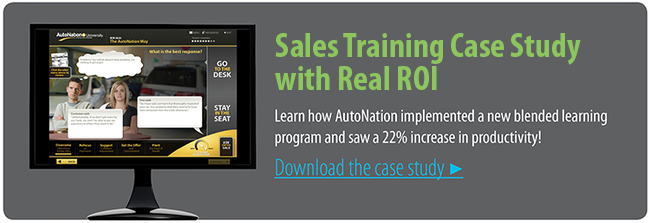Blog
If You Build It, Will They Come? Why Marketing Your Learning is Vital to ...
by Angel Green, senior instructional strategist | @LearnerAdvocate


Blended Learning: How to Select the Right Mix of Modalities
By Angel Green | June 20, 2013 | Custom Learning | 0 Comments
by Angel Green, senior instructional strategist | @LearnerAdvocate

When people think of Allen Interactions, they often think of our “No Boring e-Learning” slogan. And, while our organization was founded by the father of e-learning, this does not mean we only create e-learning. Often, like you may have read about in our case study for AutoNation, we partner with organizations to create an entire blended learning strategy and program.
The beauty of Allen Interactions’ CCAF Instructional Design Model of Context, Challenge, Activity, Feedback and instructional philosophy of Meaningful, Memorable, and Motivational learning is that both hold true regardless of instructional modality.
Blended learning programs, when done the right way, offer learners the benefits of spaced repetition, potential for social connections, and the guidance and mentoring of a knowledgeable expert. When done the wrong way, however, blended learning programs can feel disjointed, frustrate learners, and waste valuable time and effort.
Often, our clients ask us, when does it make sense to blend? What is the right blend? How do I blend? Well, like many other things in life the answer is …it depends. Unfortunately, there is no magic formula you can plug into a spreadsheet to get the right mix. It’s our job, as instructional designers, to construct a blend that makes the most sense for the learners and for the organization.

That being said, after years of designing more than my fair share of blended learning programs, I do have some suggestions as you.
One key to designing an effective blended learning program is choosing the right mix of modalities. To help determine the delivery mechanism for the content you must separate the “know” from the “do”. For each topic, ask if this is something a learner needs to do or something they need to know. This gives you a great starting point. The “need to know” can be categorized in the information sharing delivery modes, while the “need to do” falls into an application bucket.
Information Sharing
When information needs to be shared with learners, choose methods of delivery which are readable, repeatable, and referenceable. For this reason, avoid using e-learning or instructor-led training (ILT) to share information. Instead, choose intranet portals, webpages, SharePoint sites, and (potentially) printed or PDF documents. The key for sharing information is to allow learners an easy way to return to the source and quickly find the information they need, when they need it.
This isn’t the Field of Dreams – just because you built it does not mean they will come. When you share information, you still are responsible for providing learners a context by which they can use the information. An effective way to do this is through scenario-driven worksheets (printed or online).
Sharing information on company history? Create a scenario where a public relations associate is questioned about the stability of the company. What information could be used to respond? Sharing product information? Have learners research and choose a first, second, and third match of product based on a customer’s need. Providing technical information? Have learners provide the answer to a mock co-worker who is receiving an error message.
This technique is a different spin on the “typical” scavenger hunts or multiple choice tests because it allows the learner to see why the information is valuable and how they might use it in their world.
Action Learning
When learners need to do something, focus your delivery modality on those which fosters application, including e-learning, instructor-led training , on-the-job activities, and action planning worksheets/coaching.
In e-learning, help learners apply knowledge and skills by designing challenge-based learning moments that provide the opportunity to try something and succeed, or fail, in a safe environment. Give real-world consequences for what success and failure will look and feel like. Build scenarios using our CCAF Design Model.
When designing ILT, it is important to show appreciation of the fact that you are able to bring employees together. All too often, we hear how difficult it is to bring people into a room together (budget, time, etc.). So, if you are given the chance to get everyone together for ILT, recognize what a valuable opportunity you actually have been given! Take full advantage of that moment by using the time together wisely. Don’t waste time sharing information that is better delivered in another format. Use the time wisely. Design the ILT course so that learners may have an opportunity to get answers to real-world questions and input from the expert – and peers– in the room.
The Blend
Once you have selected your delivery modalities, how do you mix it together to make the right blend? My advice, like many others in the field, is to start with the end goal in mind. What does success look like? After the entire program is complete, what performance/business results are you looking to improve or create? Then, qualify the question by asking what success looks like along the way. What does success look like after one week, one month, one quarter, one year? The answer to these questions should provide insight into the right way to space and sequence events to support what learners need to be doing at each phase in the timeline.
Remember, whatever blend of learning you choose to create, it still needs to be meaningful, memorable, and motivational. All too often, learner engagement tanks from the start of a blended learning program because participants don’t see the why factor. They need to be motivated to learn. They need to see how this program, and each component in the program, can help them be successful in their job.



About the Author: Angel Green
Angel Green is a senior instructional strategist for Allen Interactions’ Tampa studio, where she is responsible for providing consultation and instructional design expertise to clients, partnering to build engaging, interactive learning experiences. With nearly 15 years of experience, Angel has worked for organizations such as IBM, MetLife, and PricewaterhouseCoopers, and holds both MS and BS degrees from Florida State University. An accomplished speaker, Angel has held positions as an adjunct instructor of public speaking and is past president of a Toastmasters International chapter. She also frequently blogs on Allen Interactions’ e-Learning Leadership Blog. Angel is the co-author of the Leaving ADDIE For SAM Field Guide. Find Angel on Google+.
Comments
Would you like to leave a comment?
Related Blog Posts

By: Angel Green | Sep, 2013
Category: Custom Learning

Blog
Using Meaningful e-Learning to Create Measurable Results
by Angel Green, senior instructional strategist | @LearnerAdvocate
By: Angel Green | Mar, 2013
Category: Custom Learning

Blog
The Key to Project Success is Commitment
by Angel Green, senior instructional strategist | @LearnerAdvocate
By: Angel Green | Feb, 2013
Category: Custom Learning
